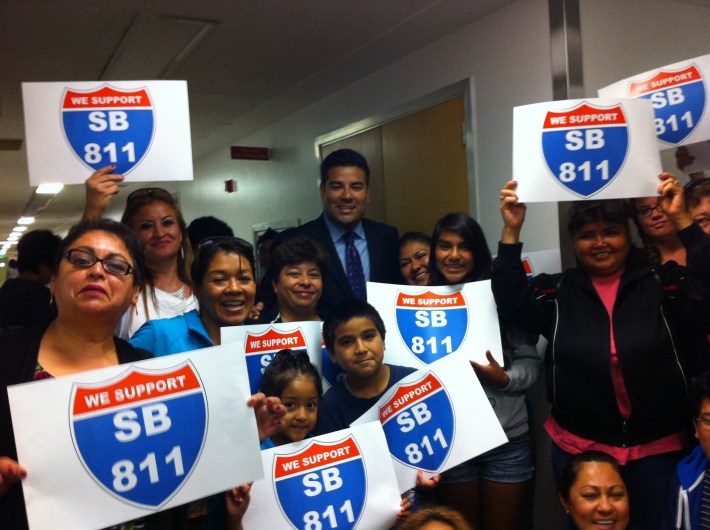It should be no shock that Sen. Ricardo Lara--who represents the 33rd Senate District spanning Long Beach to Huntington Park--has a vast interest in protecting neighborhoods that line the 710 as it goes through its proposed expansion. His most recent attempt to empower neighborhoods, SB 811, would help give communities a greater say in whether or not Caltrans goes forward with a massive widening spanning Long Beach to East Los Angeles.
SB 811 ispopular with his constituents. Before a key vote in the Assembly, Lara offered a bus to more than 50 Southern Californians from his district to take a very long, leave-at-midnight-seven-hour trip to Sacramento to participate. The legislation passed the Assembly Transportation Committee 10-2.

A native of the 6.5 sq. mile city of Commerce--where the 5 and 710 both slice through--and the son of immigrants, Lara has personally experienced the struggle of not just coming from a family that consistently worked, but one which was continually surrounded by growing traffic arterials.
During adolescence, Lara saw the 710 grow from a simple passageway to an Interstate but was removed from the backlash of the Golden State Freeway's proposed Los Angeles area construction in 1953. The latter project--some twenty years before Lara even came into existence--has an interesting tie with many of Lara's own struggles. The proposed I-5 construction at the time largely marginalized an already-marginalized Mexican-American population, as noted in Ernesto Chavez's book Mi Raza Primero! Construction of the freeway went ahead despite opposition.
One can call it experience--given his childhood in Commerce--or one can call it the aligning of stars--many L.A. communities were ultimately disregarded in the construction of the 5--but it goes to show that Lara both recognizes his routes as well as his history.
The 710 has essentially become a core arterial in goods movements as cargo volumes from the Port of Long Beach and Los Angeles have exploded--which has also in turn made the trucks using the 710 explode in numbers as well. It acts as the main connector from the ports to each L.A. rail yard--Vernon and East Los Angeles--as well as connecting to the 60 and 10 freeways for access to the San Bernardino and Colton rail yards.
The specific expansion between Long Beach and East L.A. has been met with fierce opposition, including three governmental committees--the Long Beach City Council I-710 Oversight Committee, the Gateway Council of Governments and The Project Committee--all rejecting plans to expand from eight lanes to fourteen.
Lara described SB 811 as "communities along the I-710 freeway have a meaningful mechanism to provide input about mitigation and local benefits appropriate freight impacts, advance sustainability and protect public health."
In more detailed terms, the bill codifies the motion approved by the aforementioned Project Committee include Community Alternative 7, a plan developed by a slew of organizations including the East Yard Communities for Environmental Justice, Communities for a Better Environment, Legal Aid Foundation of L.A., Long Beach Alliance for Children with Asthma, Natural Resources Defense Council, Long Beach Community Action Partnership, Coalition for Clean Air, and Physicians for Social Responsibility.
Dubbed the "communities' build option," Alternative 7 proffers a committed zero-emissions design that includes a public transit element, biking/pedestrian elements, river improvements, and a public-private partnership for an employer-operated freight system which avoids the 710 expanding.
The bill is moving in both chambers at the same time. It's next stop will be in front of the Senate Appropriations Committee.






